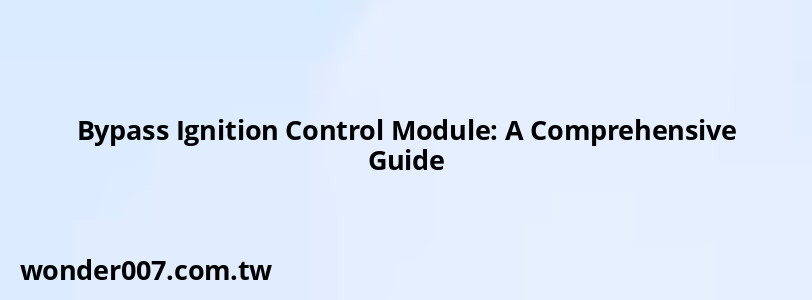Bypass Ignition Control Module: A Comprehensive Guide

Bypassing an ignition control module (ICM) can be a necessary procedure for troubleshooting or temporary fixes in automotive systems. This guide provides essential information on how to bypass the ICM safely and effectively, while also highlighting important considerations.
Understanding the Ignition Control Module
The Ignition Control Module is a critical component in modern vehicles, responsible for managing the ignition timing and ensuring proper engine operation. It receives signals from various sensors and controls the ignition coil to produce the spark needed for combustion. However, when the ICM malfunctions, it can lead to starting issues or engine performance problems.
Reasons for Bypassing the Ignition Control Module
- Diagnostic Testing: Bypassing the ICM can help diagnose whether the module is faulty.
- Temporary Fix: In case of an ICM failure, bypassing may allow the vehicle to run temporarily until repairs can be made.
- Modification: Some enthusiasts may choose to bypass the ICM for performance modifications or when installing aftermarket ignition systems.
How to Bypass the Ignition Control Module
Required Tools and Materials
- 12V SPDT automotive relay
- Jumper wires
- Basic hand tools (screwdrivers, pliers)
- Multimeter (for testing)
Steps to Bypass
1. Safety First: Disconnect the vehicle's battery to prevent any electrical shorts or shocks.
2. Locate the ICM: Identify where the ignition control module is located in your vehicle. This is usually near the ignition coil or within the engine compartment.
3. Disconnect Wiring: Carefully disconnect all wiring harnesses connected to the ICM. Take note of their positions for reinstallation.
4. Prepare Relay: If using a relay, configure it according to your vehicle’s specifications. You may need to modify it by removing internal components or soldering connections as per your requirements.
5. Connect Relay:
- Connect one side of the relay to the positive terminal of the ignition coil.
- Connect the other side of the relay to a power source (usually from the battery).
- Ensure that all connections are secure and insulated to prevent shorts.
6. Test Connections: Reconnect the battery and use a multimeter to check that power is flowing correctly through your new setup.
7. Start Vehicle: Attempt to start your vehicle. If successful, monitor its performance closely for any irregularities.
8. Reinstall ICM: If you plan on making this a permanent solution, consider reinstalling or replacing the ICM as soon as possible, as bypassing it can lead to engine management issues.
Important Considerations
- Temporary Solution: Bypassing an ICM should only be a temporary solution. Driving without an operational ICM can lead to increased emissions and potential damage to other engine components.
- Legal Implications: In some regions, bypassing emissions-related components may violate local laws. Always check regulations before proceeding with modifications.
- Professional Assistance: If unsure about any steps in this process, consult with a professional mechanic or automotive technician.
FAQs About Bypassing Ignition Control Modules
- Can bypassing an ICM damage my vehicle?
Yes, it can lead to improper ignition timing and increased emissions. - Is it safe to drive with a bypassed ICM?
It is not recommended as a long-term solution; use only for diagnostics or temporary fixes. - How do I know if my ICM is faulty?
Common symptoms include engine stalling, difficulty starting, or poor performance.
Related Posts
-
Catalytic Converters for 2000 Ford Expedition: Guide
29-01-2025 • 246 views -
Glow Relay Short Circuit: Troubleshooting Guide for Hyundai Sonata
29-01-2025 • 245 views -
2015 Hyundai Santa Fe: Essential Oil Filter Guide
28-01-2025 • 178 views -
2014 Honda Accord Drive Belt Diagram Guide
27-01-2025 • 181 views -
2012 Toyota Corolla Bluetooth Troubleshooting Guide
28-01-2025 • 185 views
Latest Posts
-
Power Steering Fluid Leak On Passenger Side
01-02-2025 • 461 views -
2015 Chevy Traverse AC Recharge Port Location
01-02-2025 • 418 views -
Rear Brake Caliper Piston Won't Compress
01-02-2025 • 361 views -
Are O2 Sensors Covered Under Warranty
01-02-2025 • 378 views -
How To Turn Off Paddle Shifters Mercedes
01-02-2025 • 387 views
Popular Posts
-
EPC Light: Understanding Causes and Solutions
26-01-2025 • 1065 views -
Hino Warning Lights: Understanding Dashboard Alerts
26-01-2025 • 796 views -
Power Steering and ABS Light On: Causes and Solutions
27-01-2025 • 650 views -
V12 Engine Costs: What You Need to Know
26-01-2025 • 688 views -
Toyota Hiace: Fuel Efficiency Insights for 2025
26-01-2025 • 646 views
